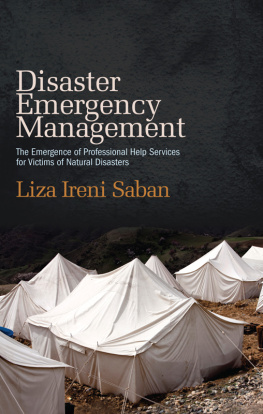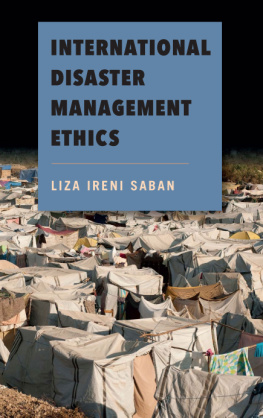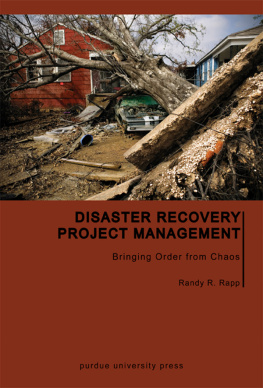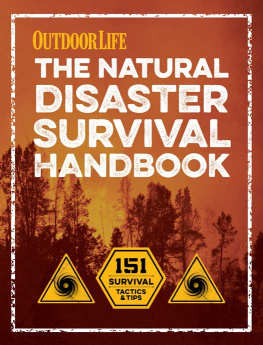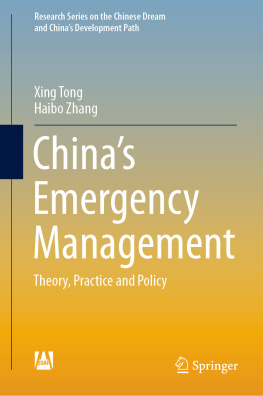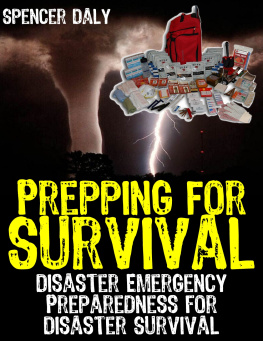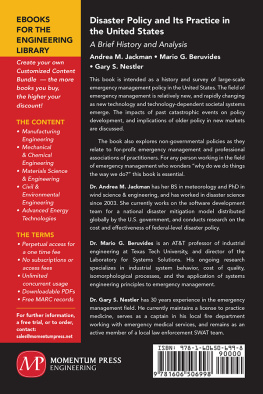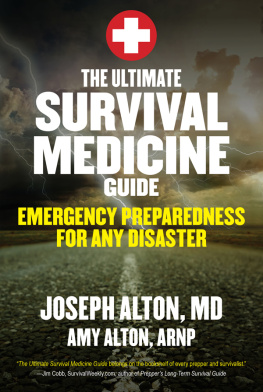Disaster
Emergency
Management
Disaster
Emergency
Management
The Emergence of Professional Help Services for Victims of Natural Disasters
Liza Ireni Saban
State University of New York Press
Published by State University of New York Press, Albany
2014 State University of New York
All rights reserved
Printed in the United States of America
No part of this book may be used or reproduced in any manner whatsoever without written permission. No part of this book may be stored in a retrieval system or transmitted in any form or by any means including electronic, electrostatic, magnetic tape, mechanical, photocopying, recording, or otherwise without the prior permission in writing of the publisher.
For information, contact State University of New York Press, Albany, NY
www.sunypress.edu
Production by Ryan Morris
Marketing by Michael Campochiaro
Library of Congress Cataloging-in-Publication Data
Saban Ireni, Liza.
Disaster emergency management : the emergence of professional help services for victims of natural disasters / Liza Ireni Saban.
pages cm
Includes bibliographical references and index.
ISBN 978-1-4384-5243-2 (hardcover : alk. paper) 1. Emergency management. 2. Crisis management. 3. Disaster relief. 4. Human beingsEffect of climate on. I. Title.
HV551.2.S23 2014
363.348--dc23
2013030308
10 9 8 7 6 5 4 3 2 1
Contents
Illustrations
Acknowledgments
I wish to thank some of the people who contributed to this book.
I would like to thank Professor Alex Mintz, Dean of the Lauder School of Government, Diplomacy and Strategy at IDC Herzliya, who has been a constant source of support and inspiration. I wish to thank Professor Dave Nachmias, head of the Public Policy and Administration program at the Lauder School of Government, Diplomacy and Strategy, for his encouragement and continuous support through this project.
Many thanks to Dr. Michael Rinella, senior acquisition editor of SUNY press, who provided professional and enthusiastic support throughout this project. I would like to thank anonymous reviewers of the manuscript. They provided extremely constructive criticism that helped me to improve the quality of the book. I would also wish to thank Ryan Morris, senior production editor, and the production team at SUNY for their editorial assistance.
I am extremely grateful to Edna Oxman for her crucial editing and formatting assistance throughout the entire project. Edna has been a great source of encouragement and support.
I would like to thank my parents, Varda and Alfred. Without their unwavering support over many years, this book would not exist.
Last but not least, I would like to thank my husband, Jacob. Jacob has been a source of continuing love, patience, and support throughout the entire project. I also wish to thank my children, Amit and Lihi, who have been a source of motivation.
This book is dedicated to the memory of my grandmother, Alisa Mansharov. Not one single day goes by without missing her.
Introduction
The question of survival in times of disaster and trauma has always been of interest to laypeople, as well as to professionals and people in positions of authority. Indeed, throughout history we have seen how some societies have flourished in times of strife while others have not. We have seen this in times of natural disaster and in times of human-made disasters. What makes nations, communities, and individuals survive is one fundamental existential question with many different answers.
Strengthening community resilience in the face of or in preparation for adversity is one possible answer. According to the Whole Community Approach, this has been a strategic goal entrenched in the U.S. Presidential Policy Directive 8 (PPD-8). The power of community resilience was well demonstrated in Japan in 2011, when a magnitude 8.9 earthquake struck off the coast, killing 15,790 people. According to the Japanese National Policy Agency, as of April 2011, the Japanese people responded to this terrible crisis with spirit and hope and stood strong despite such tragedy. Foreign journalists and scholars such as Gregory Pflugfelder, director of the Donald Keene Center of Japanese Culture at Columbia University, emphasized the role of local communities and civil organizations in manifesting effective disaster response efforts.
This book suggests that as long as this bottom-upness of disaster emergency management processes continues to persist, the capacity of policy makers and public administrators to approach emergency management with the kind of resilience needed is greatly undermined.
The originality of this book rests in bringing a new impetus to the role of public administrators as professional helpers in serving and
This implies the need to focus on the normative and practical aspects of the forms of interactive governance networks between public administrators and affected communities in disaster response and recovery efforts. This book will highlight how public administrators, namely local and street-level public officials, should strengthen their communities capacity to meet their shared interests as a proactive measure ensuring very basic community resilience capacity building, including strengthening a sense of belonging, trust, and collaboration with and among members of affected communities.
Disaster response and recovery are often characterized by nonhierarchical networks that cross many sectors. Research on governance networks in emergency management was developed in critical opposition to the traditional focus on government and top-down steering. Many of the most innovative and effective initiatives to address disaster relief and recovery efforts have been designed and implemented by civil society groupsinternational nongovernment organizations (INGOs), nongovernment organizations (NGOs), and local groups. Moreover, it questions the value of disaster management agencies to design, administer, and evaluate policy responses if better work can be done by civil society organizations. Civil society organizations may not have complete understanding of the wider socioeconomic context in which proposed actions would occur.
For that, the present book argues for asymmetric interdependencies, which means that some actors are more central than other actors. Devoting attention to the top is not to privilege elite policy makers but to make normative and practical diagnoses of how disaster management
The emphatic plea that the importance of the state (hierarchical form that underlies top down) must be incorporated into governance networks is made by the juxtaposition of network and hierarchic forms of governance. The possibility of mutually reinforcing interaction between the state and civil society to create more power on both sides in specific situations depends on the feasibility of institutions that can link state power with social forces. Thus, the present book suggests that public administration can facilitate the possibility of mutual empowerment through collaboration with active civil associations in times of natural disaster.
When natural disasters occur, public officials, namely local and street-level administrators rather than the government itself, find themselves on the front line in dealing with complex public problems. As a result, public officials act as the middle man interacting with government officials, communities, nongovernmental organizations, and the private sector. This is not an easy task in good times and certainly not in times of crisis and disaster. Recent studies on disaster management, rescue, and relief measures have reinvigorated heated debates and concerns over the breakdown of government and bureaucratic decision-making in the face of pressing need.

